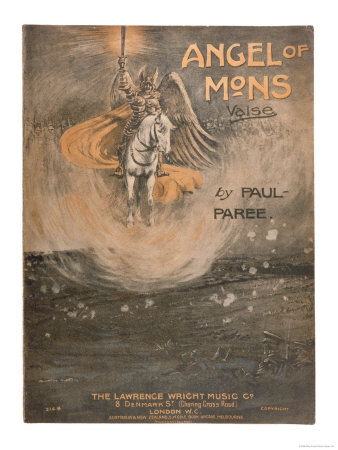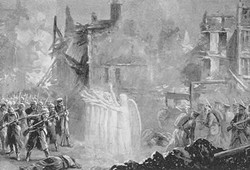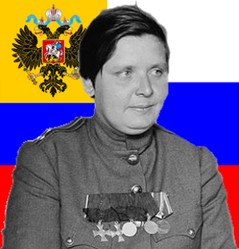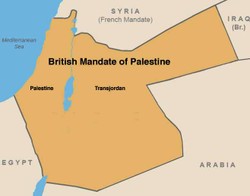For the men going into that carnage, there was a sense of patriotic fervor prevailing over all anyway. Added to that was the notion that the Almighty Himself was on the side of Britain - this demi-paradise, this other Eden - and what further evidence was needed of that than the fact that the sun never set on the British Empire?
Mons was a slap to morale, that was true. But the Almighty had so marked Britain for greatness, that even its dead returned to make good any deficiencies. Nothing could possibly go wrong.
For the wives, mothers, sisters, daughters and sweethearts left at home, it was a comforting thought to imagine that something supernatural would keep their men safe. If not God, then ghosts.
For the owners and editors of newspapers, it was a story which sold papers. Hence it kept on being told, with embellishments and in differing versions. This is why the legend as exists now isn't quite the same as that printed as The Bowmen.
For the clergy, there was much to recommend in this tale. Though they didn't know it, they were presiding over the last generation of British with an almost universal Christian faith. The First World War would do much to shake those beliefs, hurtling Britain towards widespread secularism.
Even so, vicars and priests across the country were increasingly having to deal with the loss of substantial parts of their congregations. Every person killed in battle required a memorial service. Each casualty left behind those in mourning.
This was the age of the 'Pal's Brigades' - friends, brothers, groups, whole communities of men - who would enlist together, serve alongside each other, and frequently all be killed en masse. Clerics were facing situations when every single member of their flock had lost somebody, and had to make sense of it.
Any wonder then that the Angels of Mons featured so heavily in sermons across Britain. Here was 'proof' of God's hand in the war. Here was the evidence that they weren't forgotten. For those losing their religion, this was also the counter-argument that God existed.
It was in Britain's churches that the longbow-men and cavalry ghosts became angels, and that was why.
For the government, the Angels of Mons was a useful propaganda tool. No smoking gun has yet been shown, proving that the War Department was behind the scores of 'eye witness accounts' that began to creep out, as the war progressed. But it does seem likely.
This theory is explored in depth by David Clarke in The Angel of Mons.
As for Arthur Machen, he constantly, loudly and publicly denied that he'd ever received any 'secret intelligence' from government, nor had he interviewed the exhausted survivors from the Battle of Mons to receive the story.
It was his own, influenced by nothing more than the history of Agincourt coupled with elements from Welsh mythology - particularly King Arthur hearing the clarion call to come and save them all, or Y Ddraig Goch rising from its cave to fight back the Germanic White Dragon - and placed in the modern day. A ghost story interwoven with Cymric Mysticism, just like 90% of everything else that he wrote.
But no-one cared to hear that. In the terrible aftermath of Mons, it was a story that soothed the national psyche and that was all that mattered.

















 St Tydecho's Churches in West Waleson 09/03/2014
St Tydecho's Churches in West Waleson 09/03/2014
 Goodies for an Outlander Premiere Partyon 03/06/2015
Goodies for an Outlander Premiere Partyon 03/06/2015
 Holocaust Memorial Day Interview with Rainer Höss, Grandson of Rudolf Architect of Auschwitzon 01/24/2015
Holocaust Memorial Day Interview with Rainer Höss, Grandson of Rudolf Architect of Auschwitzon 01/24/2015
 Romantic Valentine Gifts for an Outlander Fanon 01/16/2015
Romantic Valentine Gifts for an Outlander Fanon 01/16/2015



Comments
When you look at history as the long view, you can see that the push towards peace and fairness is actually happening. It's a slow process though. Very, very slow.
Believe it or not, the 20th century was one of the most peaceful centuries in history. There were two world wars; the clash between Capitalism and Communism; and armies camped out wherever there was oil. But compared to the centuries which preceded it, much fewer people worldwide were entrenched in war and dying in war.
A cold comfort for those involved in one though.
I don't know if you have read, listened to or seen the Hungergames but it is about 'staging' -staging realty. In the end, global peace might be about the capacity to "see through" staging and then to remain awake long enough to resist. We used to teach something in schools called "Resistant Reading" that style of teaching fell out of favour at least and was 'stopped' especially in USA.
1. see through staging
2. resist (your story about Reditt is one example)
3. re-imagine
4. tacitly, honestly and democratically implement
5 continue to hold to honesty
Happily ever after (?) Jo
Oh my gosh, yes! I hadn't thought of it in comparison to 'War of the Worlds'. But this one soothed, where the other panicked.
And there were stories on the radio that could be mistaken as news. Such as War of the Worlds!
Jo
cmoneyspinner - I love the capacity of the human brain to protect us. I've also seen some amazing things under duress, and felt unbelievable too, while in extreme danger.
Yes, these men were in a very bad place, physically and emotionally, so hallucinating wouldn't be too far off the mark.
Ember - Yes, it was very common to have fiction in the papers. *insert joke about the veracity of today's newspaper stories*. This was open fiction though. The original Sherlock Holmes stories were found in a newspaper.
Wow, that's kind of funny, and really interesting.
It was common at the time to have fictional stories published in newspapers, right?
I'm not disappointed that the angels of Mons turned out to be a hoax. Quite the contrary. When one thinks that they are knocking at death's door, it shows how the human spirit and mind can summon the necessary “mental, emotional, psychological and spiritual weapons” to defend themselves and find the strength to survive.
Think about it. You're some place and you're terrified. You don't know if you'll be able to escape and live through it. Your mind kicks in and says “You got a protector. Don't worry.” Somehow you manage to live to tell.
I know this can happen because one time my late sister and I went somewhere and we were so scared. Didn't know if we would make it home safely that night. I looked up and saw Jesus Christ with outstretched hands looking at me!! And of course I know I had not really seen Jesus. Why? Because the image I saw, or rather imagined, looked just like all the other common paintings and pictures of Jesus that we are all so familiar with, and we know that there are no images of Jesus when He walked the earth. So nobody knows what Jesus looked like for real!
Nevertheless I want you to know however that we made it home safely. But also know that the sighting of that image is what gave me courage to KNOW that I would make my way home! I had a Protector! I was not alone and helpless.
(Actually I still believe I have a Protector, but I don't need to physically see Him to have the assurance that He will help me through all my trials and tribulations.)
YAGW!! Yet another great Wizzle! :)
In truth, so did I the first time I heard it. I thought it was exhaustion and the stress of battle. Then again, part of it could have been. Those retreating did claim genuinely to have seen the cavalry hurrying by, but their stories only emerged after this was one of the most famous stories in Britain.
Very interestingIand informative, Jo. I have never believed in the tale, but I had thought it just an illusion generated by battlefield stress. Now I know better.
Thank you. :) History fascinates me, so I'm always on the hunt for the stories behind the stories. :)